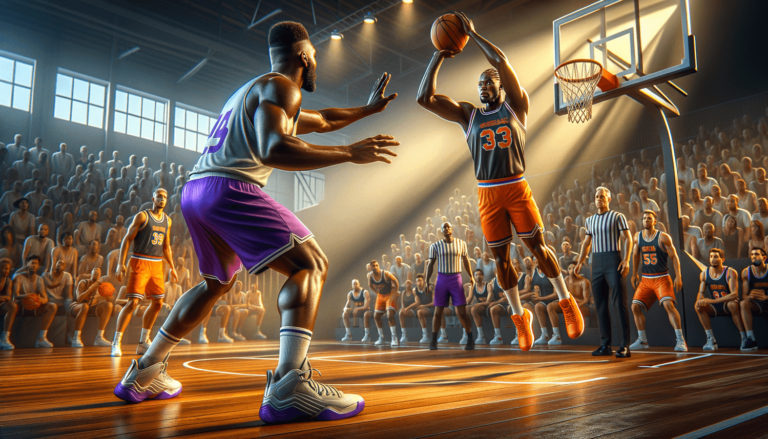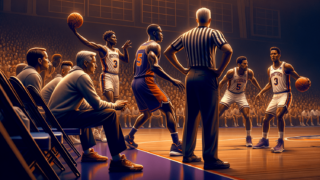
Offensive and Defensive Goaltending: What Are They?
Written by: Basketball Universe
Last updated:

As a basketball enthusiast, it’s impossible not to get hyped up whenever you witness a thrilling block or a clutch basket in the nick of time! In this exhilarating game, two essential yet slightly misunderstood elements are offensive and defensive goaltending. So, fasten your seatbelts, dear hoop lovers, as we dive deep into the world of goaltending! We’ll break down both offensive and defensive variations, shedding light on their nitty-gritty nuances, ensuring that by the end of this post, you’ll have a comprehensive understanding of these game-changing aspects. Let the knowledge slam-dunk begin!
Offensive and Defensive Goaltending: What Are They?
Offensive and defensive goaltending are rules in basketball that prevent unfair play around the basket. Offensive goaltending occurs when an offensive player interferes with the ball’s trajectory while it’s on a downward path towards the hoop or while it’s on, above, or within the cylinder. Defensive goaltending happens when a defensive player interferes with a shot in the same way. Both actions result in a violation, giving the opposing team points, or possession of the ball, depending on the league and the goaltending type.
Understanding the Intricacies of Goaltending
In the mesmerizing world of basketball, goaltending rules are pivotal in maintaining fair play and balance in the game. Before we dive into the specifics, let’s make sure we’re on the same page with a brief introduction to basketball rules that pertain to goaltending.
To Goaltend, or Not to Goaltend: The Criteria
Not every jump or shot in basketball constitutes goaltending. Let’s dissect the criteria that help us determine goaltending in befitting situations:
1. Timing is Everything
In goaltending scenarios, timing is crucial – whether we’re talking about offensive or defensive goaltending, it all boils down to when the interference takes place. The ball must be on its downward flight towards the hoop, or it must be on, above or within the cylinder during the interference.
2. Direction of the Ball
Oftentimes, defensive goaltending can occur if a player interferes with the direction of the ball or changes the trajectory of the supposedly successful shot. However, if an interference or block only happens after the ball has hit the backboard, it’s a clean block.
Spotlight on Offensive Goaltending
When it comes to offensive goaltending, it’s all about the offensive player interfering with their own team’s shot. This might raise a curious question: why would a player jeopardize their team’s chances of winning? Let’s find out!
How Offensive Goaltending Takes Place
An infringement occurs when the offensive player touches the ball while it’s on its downward trajectory, after having touched the backboard, or while it’s directly above the cylinder. This interference can happen for various reasons:
- The offensive player may be overeager to score by putting their hand on the ball, thereby displacing it.
- A teammate’s shot might seem short, and the offensive player might want to give it that extra little push.
- The offensive player may try to tap the ball back in while it’s in the air, believing that it would miss the basket otherwise.
Consequences of Offensive Goaltending
In the case of offensive goaltending, the play is immediately called dead, and possession of the ball is awarded to the opposing team. This rule deviation disallows the basket, sending the crystal-clear message that unfair play is not tolerated. Sometimes, however, players might risk an offensive goaltending call to save their shot, believing that the ball might miss the hoop otherwise.
Spotlight on Defensive Goaltending
Now we shift our attention to defensive goaltending, focusing on how it takes place, its consequences, and its influence on the game dynamics.
How Defensive Goaltending Takes Place
Upon determining that the ball has met the aforementioned criteria, defensive goaltending is ruled when a defensive player interferes with the ball’s path to the hoop. Possible scenarios include:
- Blocking the ball after it has hit the backboard but is on a clear trajectory to enter the hoop.
- Changing the ball’s trajectory during the downward flight.
- Touching the ball while it’s directly above the cylinder and has not yet made contact with the rim, backboard, or another player.
Consequences of Defensive Goaltending
Unlike offensive goaltending, defensive goaltending results in the basket being automatically awarded to the opposing team. Depending on the league, the team might also gain possession of the ball or have it returned to the original shooter for a free throw, as commonly seen in the FIBA league.
Goaltending in the College Game
In the college basketball scene, goaltending rules remain consistent for the most part, while holding slight variations. For instance, in the NCAA Men’s basketball rules, an additional situation arises in which goaltending is called if the ball is completely outside the imaginary cylinder, but a part of the player’s hand or arm is in the cylinder during the touch).
Why Knowing Goaltending Rules is Crucial
Understanding goaltending rules in-depth and putting them into practice is essential for both players and avid fans of the sport. It ensures that players can avoid unnecessary violations and take advantage of goaltending situations through smart play, resulting in enhanced on-court efficiency.
Enriching Your Basketball IQ
A deep knowledge of goaltending intricacies can elevate your engagement with the game, whether you are playing, coaching, or spectating. The ability to spot goaltending when it occurs on the court can come in handy for both casual conversations and technical analysis. So, immerse yourself in the world of basketball rules, goaltending, and beyond, taking great strides in becoming well-versed in the sport you love!
Now It’s Your Turn – Play Fair and Play to Win!
With a newfound understanding of goaltending rules, you’re now ready to slam-dunk in your conversations, match analysis or coaching sessions. You can now appreciate the game of basketball from a different perspective, based on the core principles of fairness, competitiveness, and excitement that elevate it.
Practice, apply, and immerse yourself in the thrilling playground of basketball, armed with advanced knowledge of offensive and defensive goaltending – paint a vivid tapestry of the game that exemplifies sportsmanship, skill, and basketball IQ!
Goaltending in Different Leagues
Although the fundamental principles of goaltending apply across various leagues, some minor differences and nuances can help you better understand the version of the game you’re watching, playing, or coaching.
NBA Goaltending Rules
In the NBA, goaltending regulations remain consistent with the general rules discussed earlier in this article. However, the NBA also recognizes the “restricted area” concept, which is an arc painted on the floor below the hoop. Defensive players cannot draw a charging foul while standing inside this restricted area.
FIBA Goaltending Rules
The International Basketball Federation (FIBA) features goaltending rules profoundly similar to the NBA, with a few minor changes. One notable difference is that in FIBA basketball, once the ball hits the rim, either the offensive or defensive players can touch it, marking the end of potential goaltending. Also, players participating in FIBA games tend to face stricter interpretations of rules, resulting in more goaltending calls.
Mastering the Art of Shot Blocking
Now that you have a firm grasp on goaltending, let’s briefly delve into the fundamentals of shot blocking, an essential skill that could win games when executed correctly without violating goaltending rules.
Timing and Anticipation
Being able to anticipate an opponent’s offensive move and accurately timing your jump is vital for a successful shot block. Remaining fully aware of the risk of goaltending allows defensive players to quickly adjust their position on the court to set up a legal block.
Verticality
The concept of verticality in basketball refers to a defensive player’s ability to jump straight up, maintaining a vertical plane without initiating contact with the shooter. By adhering to this concept, players can proficiently block shots while dramatically reducing the risk of goaltending or committing a foul.
Putting It All Together
With a comprehensive understanding of offensive and defensive goaltending rules and the art of shot blocking, you can improve your game performance or better analyze and appreciate the sport. Remember, each league may have its specific nuances when it comes to goaltending, so familiarize yourself with the respective rules to stay up-to-date with your preferred league.
Ultimately, knowledge and application of goaltending rules, combined with mastery of shot blocking, can significantly enhance your basketball IQ, sportsmanship, and overall experience of the game. Play fair, play smart, and play to win!
Frequently Asked Questions
We understand that goaltending rules in basketball can sometimes be a bit tricky to comprehend. To help clarify any lingering doubts, here’s a handy FAQ section addressing some of the most common questions related to offensive and defensive goaltending.
1. What is the main difference between offensive and defensive goaltending?
The primary difference between offensive and defensive goaltending lies in the player committing the violation: offensive goaltending takes place when an offensive player interferes with their team’s shot, while defensive goaltending occurs when a defensive player interferes with the opposing team’s shot.
2. Are the consequences of offensive and defensive goaltending different?
Yes, the consequences of offensive and defensive goaltending are different. Offensive goaltending results in the play being called dead and the opposing team gaining possession of the ball. In contrast, defensive goaltending leads to the basket being automatically awarded to the offensive team, and depending on the league, the opportunity for a free throw or ball possession may also be granted.
3. What is the criteria for determining goaltending?
The key criteria for determining goaltending revolve around timing and direction. Goaltending is called when a player interferes with the ball while it is in its downward flight towards the hoop or while it is on, above or within the cylinder that extends upwards from the rim. The interference must influence the ball’s likely trajectory or outcome.
4. Can a player legally block a shot after it has hit the backboard?
A player can legally block a shot after it has hit the backboard only if the ball is not on a downward trajectory towards the hoop, and not in or above the cylinder. If these conditions are met, the block is considered clean and goaltending is not called.
5. How do goaltending rules differ between the NBA and FIBA?
While the basic goaltending rules are similar for both the NBA and FIBA, FIBA features a more lenient rule regarding touching the ball after it hits the rim; players from either team can touch the ball without incurring a goaltending violation. In contrast, the NBA has a restricted area under the basket where defensive players cannot draw a charging foul.
6. What is the restricted area?
The restricted area is an arc painted on the floor below the basket in the NBA. When a defensive player is standing inside this area, they cannot draw a charging foul, thus discouraging excessive contact near the basket for the sake of player safety.
7. Are goaltending rules the same in college basketball?
Goaltending rules in college basketball are mostly consistent with those in professional leagues, although there may be some slight variations. For example, NCAA Men’s basketball adds an additional goaltending scenario where the player’s hand or arm is in the cylinder during a touch, even if the ball is outside the cylinder.
8. Is it legal to “pin” the ball against the backboard?
Pinning the ball against the backboard can be legal, as long as it meets specific goaltending criteria. If the ball is not in or above the cylinder, on a downward trajectory towards the hoop, or has not yet hit the backboard, a player can pin the ball against the backboard without committing a goaltending violation.
9. Is a player allowed to touch the top of the backboard or the supports during a block attempt?
While touching the top of the backboard or the supports does not directly lead to a goaltending call, doing so may result in other violations, such as basket interference or a technical foul, depending on the specific league rules and the player’s intent or impact on the play.
10. Can a goaltending call be reviewed or overturned?
In certain leagues, goaltending calls can be reviewed and potentially overturned under specific circumstances. For example, in the NBA, referees can review goaltending calls in the last two minutes of regulation time and during overtime. The referees use instant replay to assess the play and make a ruling on whether the original goaltending call was accurate or not.
Featured Posts
- No pillar pages found.





